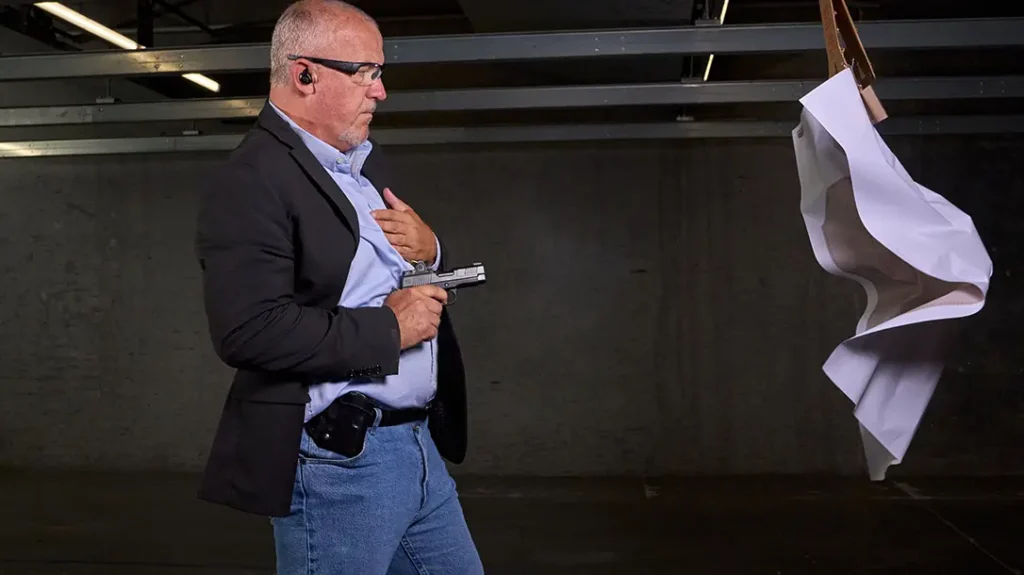Those with CCW permits work hard to keep that self-defense handgun discrete and undetectable, so no one realizes we’re carrying a gun. Criminals, however, are less methodical in their approach, often telegraphing the presence and even location of an illegal gun — and a recent Department of Justice report details many of the clues.
“Violent Encounters: A Study of Felonious Assaults on our Nation’s Law Enforcement Officers” dissects incidents, interviews convicted criminals and provides a variety of observations tailored to maximize the safety of law enforcement officers. The 176-page report, released in August 2006 by the Department of Justice and FBI, contains an entire section on the traits of criminal gun carry. It also includes knowledge provided by previous publications in 1992 and 1997.
Advertisement — Continue Reading Below
The average gun owner doesn’t make traffic stops or warrant arrests, but the information helps anyone make a better-educated determination if someone might be carrying a gun. While that doesn’t automatically mean danger, it is often good information to know.
Clothing Can Indicate Carrying a Gun
Print Job: A handgun’s grip can print or bulge against a shirt, CCW holders know this too well. But wrinkling can also appear after seats and seat belts have repeatedly pressed clothing against guns.
Odd choices: Someone wearing a heavy coat on a sultry day should be a concern. The study also mentions multi-layered clothes, “…such as two shirts or a pair of sweatpants over a pair of jeans, during weather and temperature conditions that make such layered attire inappropriate, uncomfortable, and excessive.”
Advertisement — Continue Reading Below
Weather resistant: On cold days, when most have zipped up tight against the elements, open coats make a draw faster. Coatless people carrying jackets draped over an arm instead of wearing them can be another concern.
Canting: The weight of a handgun in a coat or trousers pocket can make it swing like a pendulum, or droop noticeably on that side.
Idle hood: “One offender in the current study stated that he had several friends who carried firearms in their jacket hoods,” the report states. Unused hoods during rain and snow, when they’d provide comfort and shelter from the elements, can be another signal.
Advertisement — Continue Reading Below
Bad day at work: Don’t judge a person by the way they dress, either. Men in suits, ties and dress slacks don’t typically leave shirts untucked, according to the report, although criminals carrying a gun apparently do.
Location: Real estate agents don’t have an exclusive on location. The study explains: “Many offenders in the three studies revealed that they purposely transported weapons in their crotch areas. They did this because of the reluctance of officers to thoroughly search this location. As a result, people should pay close attention to protrusions or bulges indicative of a foreign object in that region of the body.”
Body Language
None — as in zero — of the criminals interviewed for the report used a holster. That lack of retention makes a huge difference, according to the DOJ, because it “…may have made their actions more exaggerated or noticeable, or it may have affected their behaviors in varied but related ways.” Slight changes in body language are, “…most observable whenever individuals change body positions, such as standing, sitting or exiting a motor vehicle.” Here are some of the things to watch for.
Advertisement — Continue Reading Below
- Hand checking — Without a holster, location is checked or adjusted often by touching and tugging. Guns are usually held in place when someone runs.
- Jock itch — As mentioned before, criminals like the crotch area. Combined with the urge to adjust and check location, though, things can get noticeable fast.
- Blading — It’s common for someone carrying to subtly turn their body away from observers in an effort to shield the gun from detection. A convicted felon cited in the report said there’s another reason. “Because they can’t see what I’m reaching for, I get that extra second.”
Cautions in the Study
The study warns: “Because observations and traits are merely indicators, readers must take into account the totality of the circumstances surrounding each observation. The goal is to assist officers in ensuring their own safety.”
Bear in mind also, that none of these tipoffs necessarily mean you’re looking at a crime about to committed or a fugitive from justice. There are more than 17 million people with valid concealed-carry permits in the United States, and many of them have the same “ticks” identified in the study.
Advertisement — Continue Reading Below
Final Word on Observation
Watching for people with criminal intent carrying a gun is good, but identifying cover, concealment and escape routes should be the priority when out and about. Those bright red emergency exit signs may be mandatory in today’s commercial operations, but good luck finding it when a situation unfolds, causing numerous people to panic.
Good self-defense instructors dispense that advice early and often. It’s easy to forget, but it took on a deadly importance after my daughter was confined to a wheelchair. She loves to bowl and we visited a nearby alley shortly after her accident. The facility is up to code, but old, and the bar/restaurant was closed and locked. That left the main door as the only public access to the building and the single marked “emergency exit” was completely across the building from the handicapped-accessible area. Getting there even required going down the side of the far lane and through a rather skinny-looking metal door the staff used to gain entrance to the pin-reset machines.
No one particularly appreciated me walking down to determine if a wheelchair could manage egress. It’s not a place we visit any more — navigating more than 60 lanes of panic-abandoned detritus would be time-consuming for an ambulatory person, and pretty much impossible by wheelchair, whether escaping a fire or felon.
Advertisement — Continue Reading Below
























